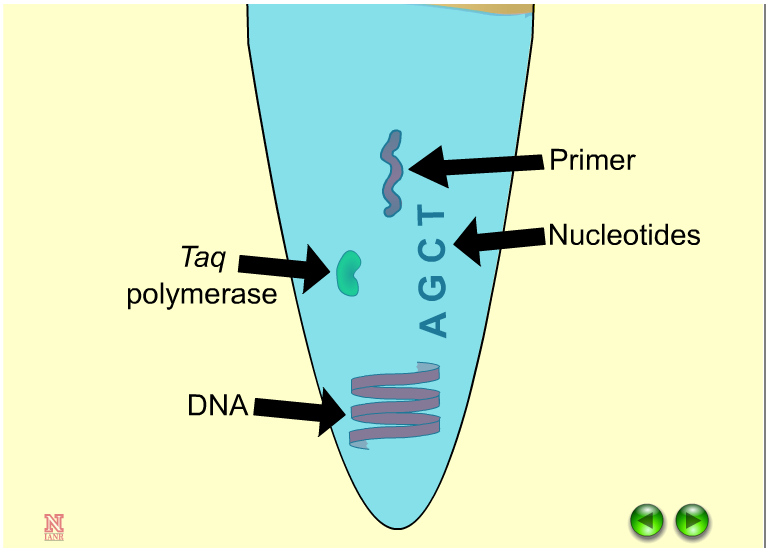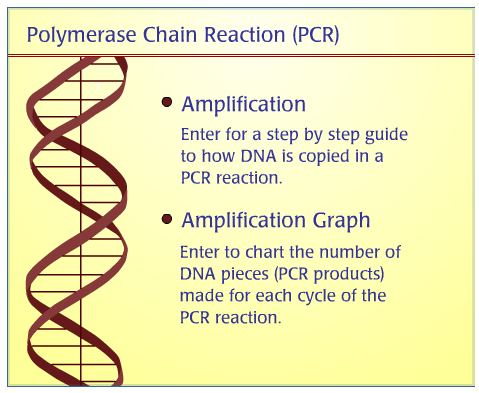Author:
Matthew Robbins, The Ohio State University
Introduction
The polymerase chain reaction (PCR) is a procedure that mimics the cellular process of DNA replication using the machinery of heat-resistant bacteria in a cyclic manner, resulting in several million copies of a specific DNA sequence that can then be visualized through electrophoresis and staining with a dye. PCR is commonly used in plant genetics and molecular breeding to copy a specific DNA fragment from the genome of an individual as a step in the process of molecular marker assisted selection. The use of PCR to copy a specific portion of a genome is analogous to photocopying a specific page of a book. Table 1 illustrates this analogy by comparing the component required to copy DNA by PCR to those needed to photocopy a page of a book.
| Photocopier items | PCR components |
|---|---|
| The book | The entire genome (called the DNA template) |
| The page | A portion of the genome (fragment) we are interested in |
| A bookmark | Primers that “mark” the specific fragment |
| The copy machine |
The enzyme that copies DNA |
| Paper and toner |
The four bases that make up DNA |
In the same way that a bookmark identifies the specific page to photocopy out of a book, PCR primers identify the specific fragment to be copied from the entire genome. In order to copy a page, the photocopier uses the paper and toner to make the copy. Similarly, the polymerase requires nucleotides to produce a replicate of the original DNA fragment.
Resources on PCR
To understand in more detail how these components function in PCR, the Plant and Soil Sciences eLibrary at the University of Nebraska-Lincoln has an informative lesson on PCR including an animation of the process:

Photo credit: Plant and Soil Science eLibrary
Another animation on PCR can be found at the Dolan DNA Learning Center, part of The Cold Spring Harbor Laboratory.

Photo credit: The Dolan DNA Learning Center
The Genetics Science Learning Center at the University of Utah also has an animation on PCR.

Photo credit: The Genetics Science Learning Center
Analyzing PCR products
When using PCR for genotyping, the amplified DNA fragments can be analyzed several different ways. DNA amplified by PCR can be:
- Seen visually by electrophoresis using several types of gels
- Cloned in to cloning vectors
- Used in subsequent genotyping assays such as allele-specific primer extension
- Directly sequenced
External Links
- Namuth, D. M. Polymerase chain reaction [Online lesson]. Plant and Soil Sciences eLibrary, University of Nebraska – Lincoln. Available at: http://plantandsoil.unl.edu/croptechnology2005/gen/?what=topicsD&topicOrder=1&informationModuleId=968252315 (verified 27 March 2012).
- PCR virtual learning lab [Online lesson]. Genetic Science Learning Center, University of Utah. Available at: http://learn.genetics.utah.edu/content/labs/pcr/ (verified 27 March 2012).
- Polymerase chain reaction [Online animation]. Dolan DNA Learning Center, Cold Spring Harbor Laboratory. Available at: http://www.dnalc.org/resources/animations/pcr.html (verified 27 March 2012).
Additional Resources
For some PCR related entertainment, we recommend “The PCR Song“. With lyrics such as “PCR, when you need to find out who’s your Daddy; PCR, when you need to solve a crime…” this video produced by BioRad features characterizations of famous and not-so-famous folk singers. If you like the musical theme, the “GTCA Song” song rocks to the tune of YMCA while reviewing the biochemistry of PCR.
- GTCA [Online video]. YouTube. Available at: http://www.youtube.com/watch?v=ID6KY1QBR5s (verified 27 March 2012).
- The PCR song [Online video]. YouTube. Available at: http://youtu.be/x5yPkxCLads (verified 27 March 2012).
Funding Statement
Development of this lesson was supported in part by the National Institute of Food and Agriculture (NIFA) Solanaceae Coordinated Agricultural Project, agreement 2009-85606-05673, administered by Michigan State University. Any opinions, findings, conclusions, or recommendations expressed in this publication are those of the author(s) and do not necessarily reflect the view of the United States Department of Agriculture.
Mention of specific companies is not intended for promotion purposes.
PBGworks 653
